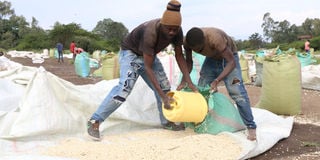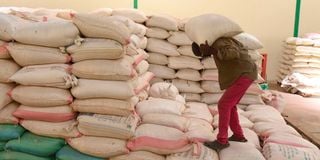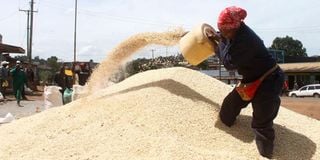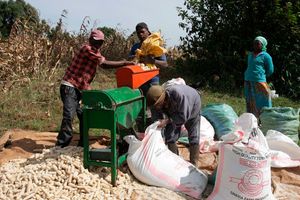
Farmers pack dry maize into bags in Nakuru County on September 23, 2024.
Kenya is going through an increasingly precarious food situation and dilemma related largely, but not exclusively, to its staple food, maize.
It is useful to look at some basic facts and figures concerning maize and food security generally to understand the fix we are getting into.
First, in spite of maize being our staple food, we are not self-sufficient in it. Average annual consumption is around 48 million 90-kilo bags and depending on the crop we produce between 20 and 30 million 90-kilo bags only.
Having a structural deficit in one’s staple food is not a disaster per se but it needs to be monitored and managed carefully. At best prices can rise and rise and at worst there can be serious shortfalls especially in deficient and famine relief areas, or both. The latter has several negative political, economic and social consequences.
Kenya is a country that is more arid and semi-arid than lush and fertile and so it arguably does not have the luxury of becoming self-sufficient. A recent report by the Henrich Boell Foundation states that only 20 per cent of Kenya’s soil is suitable for food production citing erosion and overuse of fertilizers as being some of the causes.
Of course, there have been schemes to try and make the country more self-sufficient such as the Galana Kulalu Irrigation project which in theory could produce another 15 million bags of maize. But it has been mired in all sorts of issues, some vexatious and some corruption-related. So the reality is that such projects and projections remain a pipedream, certainly for the foreseeable future.

A worker offloads bags of maize at the Nakuru NCPB depot on January 31, 2024.
Kenya relies on cross-border imports of maize from Uganda, Tanzania and even Zambia to make up the structural deficit and that is where the story get interesting and potentially worrisome at present. It also resorts to importing maize from Southern Africa and Latin America when push comes to shove.
That current supply of informal cross-border imports has reduced to a trickle and is arguably fast drying up. First, there is the issue that the harvests in these countries has been below normal, putting pressure on the relevant country’s food sufficiency and security.
Tanzania, for example, has restricted the movement of maize to Kenya.
There is also the factor the Southern Africa has been going through a series of droughts which has sucked in maize from wherever it can get it. So Kenya is in a bind. We are traditionally deficient in maize production and we are not getting the cross border imports which usually mitigate that and often make up that deficiency.
There are other factors as well such as the efficiency or otherwise of the parastatal National Cereals and Produce Board. Farmers tend only to use it as a last resort because of the prices they pay and how long it gets to receive the money for any deliveries.
Another factor is the Government’s official stance against GMO which certainly makes it difficult to import from outside Africa. This increasingly tight supply side combined with the other factors has meant that the upward price pressure on maize has intensified.
In September 2024 the farm gate price for a 90 kilo bag of maize was sh2500 per bag. Now it is sh4000 per bag and rising. This has had an effect on the retail price of a 2Kg packet which has gone up from below sh90 to sh140 even sh150.

Maize prices in major markets have eased due to a steady stream of supply of the staple following onset of the harvesting season.
The likelihood is that this will continue to rise for the next few months until there is a harvest from the crop planted with the ongoing rains. Any commercial imports from countries such as Mexico and Brazil have a time lead so yet again we have a tight supply chain for the next three months or so.
There is the additional factor that the white maize market is a relatively thin and confined one worldwide so is not prone to vast surpluses as with for example yellow maize. Rising maize prices are going to be the major concern and factor for many, government included, for the next few months.
What can the government do to at least alleviate the pain? First it must ensure that the relevant arms and legs of government act equitably and transparently in the storage and distribution of what stocks there are left. Famine relief aid is vulnerable to misuse and abuse.
Secondly it should facilitate, but not get directly involved, in the importation of yellow maize that can then be used for animal feed thus releasing white maize for human consumption.
That involves an import window and a temporary withdrawal on yellow maize imports for a fixed period of time. It is essential that licensed traders with credibility are encouraged rather than briefcase merchants.
It must be emphasised that time is of essence so there should be no delays. Indeed this begs the question about why such a plan is not already in place.
Of course some will argue that this is a tall order with such a government but it is important to emphasize the extreme gravity of the situation which could easily result in extensive social fluidity.
To put it more bluntly hungry, angry people are not what this government needs or wants. Historically speaking such a situation can be a ticking bomb and arguably the clock is ticking.
Robert Shaw is an economic and public policy analyst:robshaw298@







